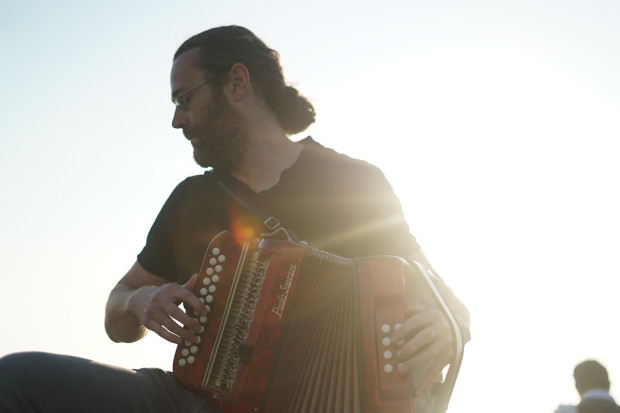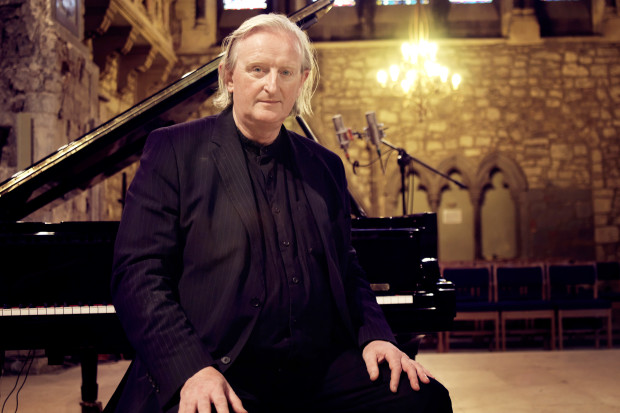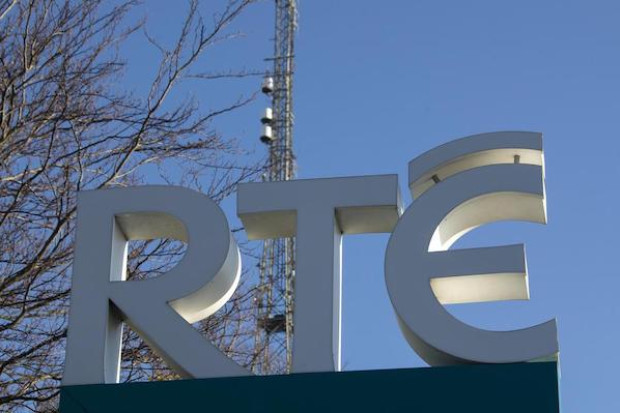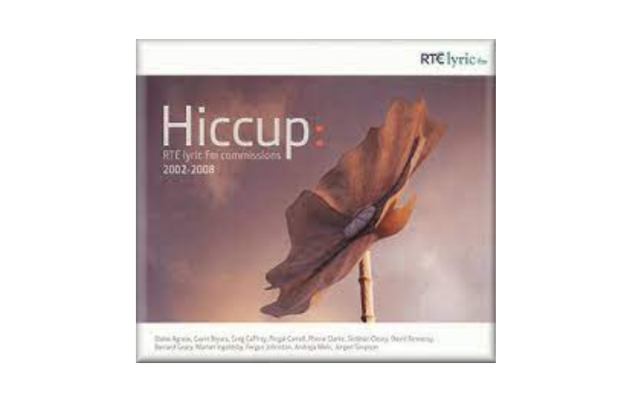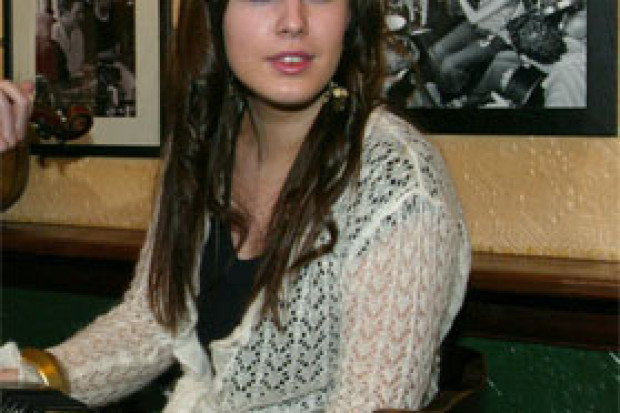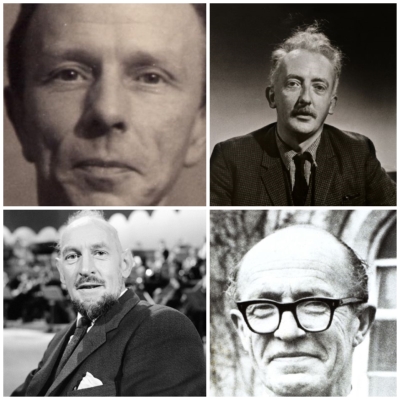
Eamonn O Gallchobhair (Top Left), Seán O Riada (Top Right), Brian Boydell (Bottom Left), Aloys Fleischmann (Bottom Right)
The National Ear: Part 2
Mutual denial
At the turn of the century, just twenty years before 2RN was established, Michele Esposito stated that too much lip-service was paid to ‘traditional’ music and not enough to the techniques and craftsmanship of the European mainstream. ‘What is “Irish” music? Is Brian Boru’s march Irish music? Well, give me the composer’s score and I’ll play it. But you can’t. You can only give me a melody sixteen bars long; no harmony, no expression’. One can readily understand the frustration of a classically trained composer when confronted with this central dilemma of Irish music: the linear defeated by the cyclic. Esposito insisted that Irishness in music was inherent rather than acquired, and said:
If your Irish composers use every modern device of the orchestra their music will be none the less Irish… The music that the future will call Irish will be written by Irishmen and will be Irish by virtue of something of his race-consciousness which his music will set free – no matter what his creed or political opinions may be. They will be ‘national’ in the same way that Dvorak and Grieg and Brahms are national. My advice to Irish composers is to master their art as musicians to the fullest possible extent, then go back to the wonderful store of folk-melodies and build them into their music.[1]
Bartók argued similarly that
in our case it was not a question of merely taking unique melodies in any way whatsoever, and then incorporating them – or fragments of them – in our works, there to develop them according to the traditionally established custom. This would have been mere craftsmanship and could have led to no new and unified style. What we had to do was to grasp the spirit of this hitherto unknown music and to make this spirit (difficult to describe in words) the basis of our works.[2]
The separatist thought in Irish music was expressed most lucidly and eloquently by two composers who, at different stages, were central to Radio Éireann’s development: Éamonn Ó Gallchobhair (1910-1982) appears to have opposed Bartók’s viewpoint, asserting that ‘the Irish idiom expresses deep things that have not been expressed by Beethoven, Bach, Brahms, Elgar or Sibelius – by any of the great composers’,[3] and went on to say (almost as if he were replying to Esposito)
What can the professor do with a perfect lyric like the ‘Derry Air’. He can look at it, divide it into its component parts and so on, but technical analysis is useless before the complexity of its unity. All the technique of modern Europe will not achieve a thing like this lyric – its roots lie far underneath the superficiality of objective thought.[4]
Seán Ó Riada also commented graphically on the divided mind of Irish music in a now legendary exchange of letters with the music critic Charles Acton, when he said:
Very broadly, … there are on this small island two nations: the Irish (or Gaelic) nation, and the pale. The Irish nation, tiny as it is at the moment, has a long, professional literary and musical tradition. The Pale, on the other hand, has a tradition of amateurishnesss.[5]
To Ó Riada, the concept of ‘development’ in a musical work was uninteresting or unnecessary, compared to the simplicity and ornamentation of the melodic line. In Our Musical Heritage he said:
By emphasising ‘traditional’ I mean the untouched, unarranged, undiluted, unEuropeanised, unWesternised, un-dressed up, native, orally transmitted music which is still, to the best of my knowledge, the most popular type of music in this country […] Irish music is not European music… Not alone is Irish music not European music, but it is quite remote from it. It is, indeed, much closer to some forms of oriental music than to European music. Therefore, the first thing we must do, if we are going to try and understand it, is to forget all about European music. Its standards are not Irish standards, its style is not Irish style, its forms are not Irish forms and so on.[6]
The enigmatic figure of Stanford appears here as one who might have been able to reconcile these seemingly opposing views. In 1899 Stanford spoke on the teaching of music in elementary schools, and advocated that
What should be taught is national music, folk music, the music which since the earliest times has grown up amongst the people. Without the foundation of such music, no healthy taste can be fostered. From all times it has been the germ from which great composers have come. The British Isles have the greatest and most varied storehouse of national music in existence. The English, strong, solid and straightforward; the Welsh full of dash and go; the Scotch a mixture of the humorous and poetic, full of strongly marked rhythm; the Irish is the most remarkable literature of folk music in the world – there is no emotion with which it does not deal successfully, and none has more power of pathos or fire.[7]
We must not overlook what Stanford wrote about nationalism in music: he pointed out that in the later nineteenth century composers began to ask wherein lay the strength, as well as the international domination, of German composers, ‘what was the fundamental factor on which the Germans depended for their inspiration. And the answer’, said Stanford,
was on their ‘nationality’. This led composers to a further inquiry – the perplexing search for the existence of a musical sanction for their activity. This search was taken up eagerly in many countries and it resulted in the rediscovery of folk-song.[8]
The experience of division, of an unnecessary separation and separateness of the two styles, has been a chief factor in creating the mindset of modern Irish musicians. Only a few, such as Seán Ó Riada and more recently Seóirse Bodley, Seán Davey, Micheál Ó Suilleabháin and Bill Whelan, who feature in the later chapters of this book, have attempted to translate the experiences of either style for the benefit of the other. That expression of Stanford’s, ‘a musical sanction for their activity’, resonates throughout the consciousness of Irish composers attempting to find different ways of being Irish and of being composers.
Throughout its history, RTÉ has carried an implicit responsibility for sustaining all forms of music, yet it has seldom been in a position to bring them forward together or to achieve more than a fleeting introduction of one to the other. Usually, the practical barrier has been that of training. Works such as Rolf Liebermann’s Concerto for Jazz Band and Orchestra or Matyas Seiber’s Improvisations for Jazz Band and Symphony Orchestra (both performed by the then RTÉSO in 1979 in an ill-conceived ‘Gala Concert of Symphonic Jazz’), suffered because the selection of a group of players from within the orchestra to form a ‘jazz band’ was flawed by the fact that the players in question had insufficient knowledge or experience of jazz performance.
Harry White has referred to expressions such as ‘the intelligence inside sound’ as ‘shibboleths of Western culture’[9] – where ‘Western’ presumably meansconcerned with the European (and North American) mainstream – and broadcasting in Ireland, as a form of education, has attempted to introduce its audiences to an understanding of that ‘intelligence’, as Brian Boydell indeed did in his radio talks for younger listeners from the 1940s onwards. It thus becomes possible for us to regard a shibboleth less as an exclusivist term defining ‘us’ and ‘them’ and more as an enabling persuasion. To say, as White does, that ‘those edifices of Western culture which authorise the conventional understanding of music’s pre-eminence play no part in the private history of most Irish men and women’[10] is to insist that the only effective means of meeting that intelligence is by way of a Western edifice, at the door of which there is a gatekeeper of fashion and tradition. He goes on to say that
Hundreds of thousands of schoolgoers pass through the structures of Irish education, a significant fraction of whom might reasonably develop skills of musical perception without which a universe of intelligent sound remains inaccessible.[11]
White’s assumption is that the ‘structures’ are unequal to the task, but if that is the case it does not necessarily mean that it is impossible to inculcate skills of musical perception. It does mean, however, that not only have the schools systems put in place in Ireland by the British administration between 1830 and 1878 proved unsuited to the inculcation of ‘Western’ skills for the youth of Ireland, but also the change of administration in 1922 implicitly decided that music of all kinds was not a priority for emergent Ireland. If there is a failure of procedure, it stems from a failure of intent and indeed a failure of imagination, at a time when the gravest decisions were being taken as to the political, social, economic and cultural future of the country. Music escaped this failure of imagination in one vital sense: the expectation that, as a cultural medium, it might prove to be a social panacea made it largely immune to inspection or discussion.
For Harry White to have spoken in his 1995 address to MEND[12] of ‘the absence of art music from the Irish mind’, and to wish for the creation of an ‘informed listenership’,[13] is to overstate the case, since the minority of those in Ireland who can listen to ‘art music’ will inevitably remain a small minority as it would be in any other country. In her study of the Celtic Renaissance, Jeanne Sheehy paid almost no attention at all to the phenomenon of music,[14] while in his more recent study, The Irish Mind, Richard Kearney and his contributors tacitly exclude the notion that music contributes to the Irish consciousness or creative process.[15] It is indicative also of the perception of music within RTÉ itself that the major ideological critique of the organisation, Sit Down and be Counted by Lelia Doolan, Bob Quinn and Jack Dowling should have ignored the subject of the station’s musical policy and output,[16] although Quinn has recently written with insight of the establishment by RTÉ of its classical music radio channel, Lyric FM.[17]
White’s point, however, is more serious:
The current projection of Ireland’s musical culture… is an emphatic repudiation of Western art music, which is a pretty stiff price to pay for the technical finesse and bravura of Riverdance and A River of Sound. I realise that it has become almost de rigueur to insist that all music is of the same specific gravity, but I am not persuaded by such political correctness in musical matters: almost any significant work from the art tradition renders such insistence absurd. Not that Riverdance should be sneezed at: snobbery will avail nothing in discriminations between different kinds of music.[18]
White would seem to be unaware of, or unconcerned by, the debate in the ‘Crossroads’ conference (1996) which was occupied by the fall-out from Micheál Ó Suilleabháin’s A River of Sound and oblivious to the fact that his reference to ‘significant work’ immediately condemns him for the snobbery which he disavows. That RTÉ should have been the forum in which both Riverdance and A River of Sound were conceived once more points to the contentious, and potentially divisive, area in which the competing claims of musical taste are to be confronted and debated.
The nineteenth-century legacy
During the nineteenth century in Ireland all forms of music suffered a debilitating decline in energy and sense of direction. Throughout the nineteenth, and for most of the twentieth century, the indigenous music of Ireland was regarded as in danger of imminent extinction. Even as late as the 1970s, Breandán Breathnach was uttering a dire warning that the heritage was about to be lost, for want of a proper means of maintaining it – a situation hopefully retrieved (in all senses) by the establishment in 1987 of the Irish Traditional Music Archive.
If folk music was in danger of extinction, conversely ‘classical’ music was ever on the threshold of being born. It is no longer valid to regard the slump in the fortunes of ‘classical’ music as being due to the exodus of the rich and powerful following the Act of Union, since we now know that the middle classes moved rapidly to fill the places of the so-called Ascendancy, and to create and maintain a new musical tradition with the vice-regal court as its hub. But it was decidedly middle class and its musical fare (largely oriented towards the Church of Ireland’s interests) was a poor reflection of that available at the charity concerts which had enlivened Dublin in the eighteenth century.
The paucity of large-scale works is therefore due to a combination of factors: famine, emigration, the continued suppression, or at least segregation, of the Catholic population, poor infrastructure, and a small audience which, to agree with White, was not an ‘informed listenership’. One could hardly disagree with the telling point made by Joseph Ryan: introducing a CD by the RTÉ Concert Orchestra entitled Romantic Ireland he writes:
It is perhaps not surprising that an emerging nation should look early to establish its own distinctive culture and it is equally not surprising that a people with a divided musical heritage should engage with shorter forms. This has been the Irish experience, with composers writing in the equivalent of the short story rather than the novel.[20]
We might say, with James Joyce, ‘history is to blame’. As a gross simplification, the conservative, urban Protestant section of the population, whether it was unionist or separatist in political inclination, looked for its intellectual nourishment to the cultural diet of Britain and Europe, which included the mainstream symphonic, oratorio and operatic traditions, whereas the nationalist, or republican, Catholic, rural section of the population looked to elements unmistakably Irish for its sense of identity. Both sectors, ironically, were looking to something of which they were unsure and which did not necessarily offer them what they needed. Both sectors would discover that they in fact had to invent that diet in order to sustain their ideas about identity and about where that sense of identity might lead them.
It may not be entirely true, as Harry White asserts, that Irish music was ‘the absolute expression of nationalist feeling, aesthetics and culture’,[21] but it was the way of saying that they were gaelic, Catholic, rural and nationalist. To espouse ‘classical’ music was not only a statement about education and class, but, perhaps, a way of saying that one did not wish to be associated with the culture of gaelic Ireland.
When Joseph Ryan argues that ‘music became indentured to political events’[22] he is in fact eliding several arguments to arrive at such a position. It is partially, although not exclusively, true that ‘composers, promoters and auditors [elected] between insularity and cosmopolitanism’ in their choice of diet.[23] One could rarely effect a transitus between the two. Yet the argument put in such a nutshell does not allow us to see the broad range of cultural, social and political factors nor the concomitant range of options. Nevertheless, it is fair to say that living in a culturally and politically emergent country, with an as yet undefined but immensely potent sense of nationalism, exerted considerable pressure on the creative imagination of composers and performers as well as on the attitudes of their potential audiences. Nationalism not only wanted independence but, in its cultural dimension, it also wanted to assert its own identity and difference. That the rejection of things English meant in effect turning one’s back on the music of Germany and Italy was merely another of the ironies of the age.
Patrick Zuk suggests that the idea of a composer ‘indentured’ to nationalism might lead us to
imagine that Irish composers worked under the expectation of producing compositions such as their counterparts in the Soviet Union felt constrained to write – paeans of praise to de Valera or odes in celebration of the Shannon Scheme, perhaps. There is nothing of this nature to be found in the work of Irish composers.[24]
This is crassly self-evident. Yet there was quite definitely a constraint felt by Irish composers which endures to the present day, exemplified in the exhortation by the Irish-absorbed Arnold Bax to write ‘Irishly’. Several of the composers whose work was important to the development of Radio Éireann experienced and expressed this creative dilemma.
Aloys Fleischmann (1910-1992), one of the most eminent of twentieth-century Irish composers, gave personal evidence of this dilemma when he wrote in 1936
Unless his music is confined to arrangements of traditional tunes, or at most to sets of variations on these tunes, he [the composer] may indeed risk being classed as Anglo-Irish, even as anti-Irish.[25]
This is not an indenture, in the sense that Ryan and White have used the term, but it does suggest a form of mental constriction, and reveals that at the core of the cultural dilemma lay an anxiety about the nature of Irishness, and about ‘how to be Irish’. The context of an emergent nation, with an emergent medium such as radio at its disposal, tied the artist to the responsibility of articulating an ‘other’ entity that could only be imagined because it had not yet come to be. I therefore think that Ryan is correct when he contends that to be clearer about what you are not rather than what you are is not a peculiarly Irish trait; it is evident in all separatist movements. But it was particularly pronounced in Ireland due to the dominance of the imported culture. Irish culture came to be defined by what it was not; it was not progressive, nor European, and decidedly it was not British. This mode of thought led to the insularity and cultural protectionism which inhibited aesthetic endeavour throughout the first half of the twentieth century.[26]
Similar evidence of this search for the way to be Irish, or to write ‘Irishly’, can be found among composers from the ‘Anglo-Irish’ tradition such as Frederick May and Brian Boydell, who – May in his String Quartet (1936) and Boydell in his Violin Concerto (1953-54) – wrote the two works of twentieth-century Ireland most committed to the international genre and most free of Irish influence of any kind. Both May and Boydell commented profoundly on the question of coming from an Anglo-Irish culture and discovering Irishness by means that were not immediately apparent or available to them in their early years. (Boydell in particular was adamant that it would have been dishonest of him to follow Stanford in writing an ‘Irish’ Symphony.) The fact that they expressed these apprehensions during a Radio Éireann series, ‘The Composer At Work’ in 1958, is an eloquent mid-century mark of the use of the medium for cultural reflection. Both these composers could, however, exhibit emotions, underpinned by cosmopolitan craftsmanship, which were unmistakeably Irish – in May’s Songs from Prison (1941) and Boydell’s In Memoriam Mahatma Gandhi (1948).
If Irish composers were not ‘indentured’ to literature and nationalism, therefore, they were – and are – quite obviously and self-consciously constrained to address a singular aspect of Irish affection which has manifold repercussions, for which there was a precedent in literature. In fiction and drama, for example, the land – both as a physical space and as a spiritual, mythological presence – exercised a powerful influence on both the factual and emotional content in work stretching from Edward Martyn’s The Heather Field (1899) through Yeats’ Cathleen-ni-Houlihan (1902) with its irredentist celebration of ‘four green fields’, George Moore’s The Untilled Field (1903) and Padraic Colum’s The Land (1905) to Denis Johnston’s The Moon in the Yellow River (1931) (which for Zuk’s edification was explicitly set against the background of the Shannon Hydro-Electric installation), John B. Keane’s The Field (1965) and Brian Friel’s The Mundy Scheme (1969) with its plot to solve the country’s economic ills by selling the west of Ireland to grave-hungry Americans as the ultimate resting-place. In music the same paradigm informs much of Irish composition. Thus the continuing affective subscription to the legend of the Children of Lir is celebrated first in Moore’s ‘Silent, Oh Moyle’, arranged by so many subsequent composers including Ó Gallchobhair, in Harty’s eponymous and wordless suite for soprano and orchestra, and in Larchet’s orchestral By the Waters of Moyle. Harty’s geographical specificity is evident in hisVariations on a Dublin Air and his Londonderry Air and in Stanford’s Cushendall. There is a distinctly Irish flavour in the latter’s The Voyage of Maeldune, while topographical dedication is continued in Bax’s Rosc-Catha and Connemara Revel. Bax introduced a mythical suffusion into his tone poems Cathaleen-ni-Houlihan,Into the Twilight, In the Faery Hills and The Garden of Fand. More recently Seóirse Bodley’s second symphony I Have Loved the Lands of Erin (also written in memoriam Pádraig Pearse) and – to return to specific thematic inspiration – Shaun Davey’s The Brendan Voyage and The Relief of Derry Symphony have borne out this continuing presence not only of a sense of place, but of place itself, personified by mythical personality both general and specific. John Kinsella (a member of RTÉ’s Music Department for twenty years, retiring from the position of Head of Music in 1988 to devote himself to composition), noted that his Symphony no. 4 (dedicated to the then RTÉ Director-General, Vincent Finn) is ‘a sound sketch of each of the four Irish provinces… Munster with its high peaks and broad and fertile grasslands, Connacht with its contrasts of warmth and sharply etched horizons, Ulster where human tragedy overshadows all other impressions and Leinster where, historically, there has been such strong centralisation of the Irish psyche’.
The nineteen-twenties
By the end of the nineteenth century, musical life in Ireland was dull. An initiative to improve the opportunities for, and the standard of, performance was the Dublin Feis Ceoil. Just as the literary movement had led to the establishment of the Abbey as a playwright’s theatre, to counter the crudity of the prevailing performances of melodrama, so in musical circles influential figures came together to set up an Irish festival modelled on the Welsh Eistedfodd. The Feis Ceoil in fact came from within the National Literary Society, and it was at a 1894 meeting of the Gaelic League (founded 1893) that Dr Annie Patterson urged its creation. Its early circumstances bear out the remark attributed to Brendan Behan, that the first item on the agenda of any organisation is to have a split, since some among the original founders considered that the Feis would not sufficiently protect and promote Irish musical culture, and thus led to the founding of a separate organisation, An tOireachtas; both bodies had Annie Patterson at their head. (One wonders what might have been the direction of the Feis if the original intention, to have Stanford as its President, had been realised.)
One of the most interesting facets of the Feis was its stipulation that in the prize for composition each movement of a symphony must incorporate an Irish melody, resulting in both Esposito’s and Harty’s ‘Irish’ symphonies. The main works which emanated from the Feis, and, later, the Oireachtas and associated initiatives were (in addition to these symphonies) Esposito’s cantata Deirdre, the song cycle Roseen Dhu and the two short operas The Tinker and the Faery and The Post-bag. In addition to his symphony, Harty won prizes annually from 1899 to 1904, with his violin sonata, two string quartets, two fantasiestücke for piano trio, and a Romance andScherzo for cello and piano. And, commissioned by the Oireachtas, came two Irish-language operas, Muirgheis by O’Brien Butler in 1903 and Eithne by Robert O’Dwyer in 1910 – a tradition to be continued in commissions to Éamonn Ó Gallchobhair in the 1950s.
But, as Harty had bluntly said, ‘Ireland offers [the music student] no scope’. Thus the inevitable exile continued. In 1936 Aloys Fleischmann had to say that its reputation for an innate musical culture was ill-founded and, in fact, Ireland had become ‘a land that is literally music-starved’.[28]
One would not go as far as Joseph Ryan, who asserts that ‘even Stanford’s industry does not alter the sorry fact that the nineteenth century cannot supply a single Irish work of enduring quality’[29] – but the argument about the viability of Irish composition is more accurately exhibited in the fact that in 1924 the critic H. L. Morrow said ‘Ireland has not produced a single symphony of any account: not even a piano concerto’.[30] (In the same year Esposito, writing to Harty, referred to the composers of Ireland collectively as ‘Vincent O’Larchet’ – the implied disparagement linking the about-to-be-appointed Music Director of 2RN with the rising musical star of the day.)
Esposito had established a professional orchestra, the Dublin Orchestral Society, in 1899, but it had collapsed in 1914. Every orchestral initiative was, and would remain, dependent on the availability of wind and brass players from the British, and later the Irish Free State, army, and the recruitment of brass players to the Radio Éireann Orchestra continued to be predominantly from the Army bands up to the 1950s.
In 1924, two years before 2RN went on air, Larchet said:
Our system of music education is not merely wrong, it is fundamentally unsound. From the primary and secondary schools all the way up through the circuitous paths and byways of individual teaching and private endeavour, the whole mental attitude is at variance with common sense… Music is generally pushed into the darkest corner of the curriculum.
So, at the same time that 2RN was being set up, Larchet pointed to the fact that there was almost no public opportunity to hear the works of the great composers: ‘Except for occasional visits from some of the British orchestras, there has been no performance of any importance or educative value in Dublin for ten years [since the collapse of the DOS]. This means that most of the people have no knowledge of Strauss, Brahms, and the great volume of modern orchestral music.’
There were thus many inherent frustrations awaiting 2RN as it set out to provide a musical service to the Irish listener in the late 1920s. Chief among these were the lack of an orchestra, lack of an adequate music education, and a dearth of composers. The major problem in Irish music education remained, and was to be the greatest obstacle to Radio Éireann’s own role, as it has been in every other musical initiative in modern Ireland: the school system, or lack of it as far as music is concerned. As a result of the lack of education, in the view of conductor and musicologist Eimear Ó Broin, ‘the lack of understanding of music as a creative intelligence in Irish society’ continues to impede its development today. The challenge to RTÉ down the decades has been to create a performing and listening environment in which that understanding of music could be facilitated. While there have been many factors both inhibiting and enhancing that challenge, successive administrators within the organisation have put forward ideas and resources at least capable of sustaining the search for an adequate means of recognising music as a creative intelligence.
Ceol-Aras: music and broadcasting in Ireland since 1926 will be published by Four Courts Press in the series ‘Broadcasting and Irish Society’ in early 2004.
Notes
1. Esposito – interview with James Cousins, Freeman’s Journal, 19 February 1906.
2.Bartók, Collected Essays, p. 332.
3. Ireland Today, no. 2, 1936.
4. Ireland Today, 1937.
5. Seán Ó Riada, ‘An Open Letter to Charles Acton’ in Bernard Harris and Grattan Freyer, The Achievement of Seán Ó Riada (Ballina: Irish Humanities Centre, 1981), pp.151-2.
6. Seán Ó Riada, ‘Our Musical Heritage’ – first programme, transmitted 6 April 1963; the extant tapes in the RTÉ Sound Archives differ in significant detail from the text of the programmes as published (Fundúireacht an Riadaigh/Dolmen Press, 1982), ed. by Thomas Kinsella. RTÉ Sound Archives tape 00604.
7. C. V. Stanford and C. Forsyth, A History of Music (London 1925), p. 209.
8. ibid.
9. H. White, ‘The Conceptual Failure of Musical Education in Ireland’ in The Irish Review, no. 21 (1997), p. 103.
10. ibid.
11. ibid., p. 108.
12. Music Education National Debate hosted by the Dublin Institute of Technology.
13. H. White, ‘Conceptual Failure’, pp. 104, 110.
14. Jeanne Sheehy, The Rediscovery of Ireland’s Past: the Celtic Revival 1830-1930(London: Thames and Hudson, 1980).
15. R. Kearney (ed.), The Irish Mind: exploring intellectual traditions (Dublin: Wolfhound Press, 1985).
16. Sit Down and Be Counted: the cultural evolution of a television station (Dublin: Wellington, 1969).
17. B. Quinn, Maverick: a dissident view of broadcasting today (Tralee: Brandon, 2001), pp. 207-219.
18. H. White, ‘Conceptual Failure’, p. 104.
19. cf. Derek Collins, ‘Music in Dublin 1800-1848’ in R. Pine and C. Acton (eds),To Talent Alone: the Royal Irish Academy of Music 1848-1998 (Dublin: Gill and Macmillan, 1998).
20. Sleeve note to Romantic Ireland: Marco Polo DDD 8.223804
21. H. White, ‘Nationalism, Colonialism and the Cultural Stasis of Music in Ireland’ in H. White and M. Murphy (eds), Musical Constructions of Nationalism: essays on the history and ideology of European musical culture 1800-1945 (Cork: Cork U niversity Press, 2001) p. 257.
22. ‘The Tone of Defiance’ in Musical Constructions, p. 207
23. ibid.
24. ‘Music and Nationalism’, a review of Musical Constructions of Nationalism, JMI2:3 (March/April 2002), p. 27
25. A. Fleischmann, Ireland Today, no. 1, 1936.
26. J. Ryan, ‘Nationalism and Music in Ireland’, PhD thesis, NUI 1991, p. 276.
27. J. Kinsella letter to Vincent Finn, 4 September 1990, RTÉ Archives.
28. A. Fleischmann, ‘Ars Nova’, Ireland Today, vol. 1, July 1936.
29. J. Ryan, ‘Nationalism and Music in Ireland’, p. 463
30. Irish Statesman, 19 April 1924. By implication, my quibble with Ryan would extend to Morrow to the extent that I would place value on Stanford’s piano concerto and of course his symphonies, and on the cello concertos of Victor Herbert.
Published on 1 March 2003
Richard Pine, Director of the Durrell School of Corfu, is a former Concerts Manager in RTÉ. He is the author and editor of books on Irish music history and of definitive studies of Oscar Wilde, Brian Friel and Lawrence Durrell.













